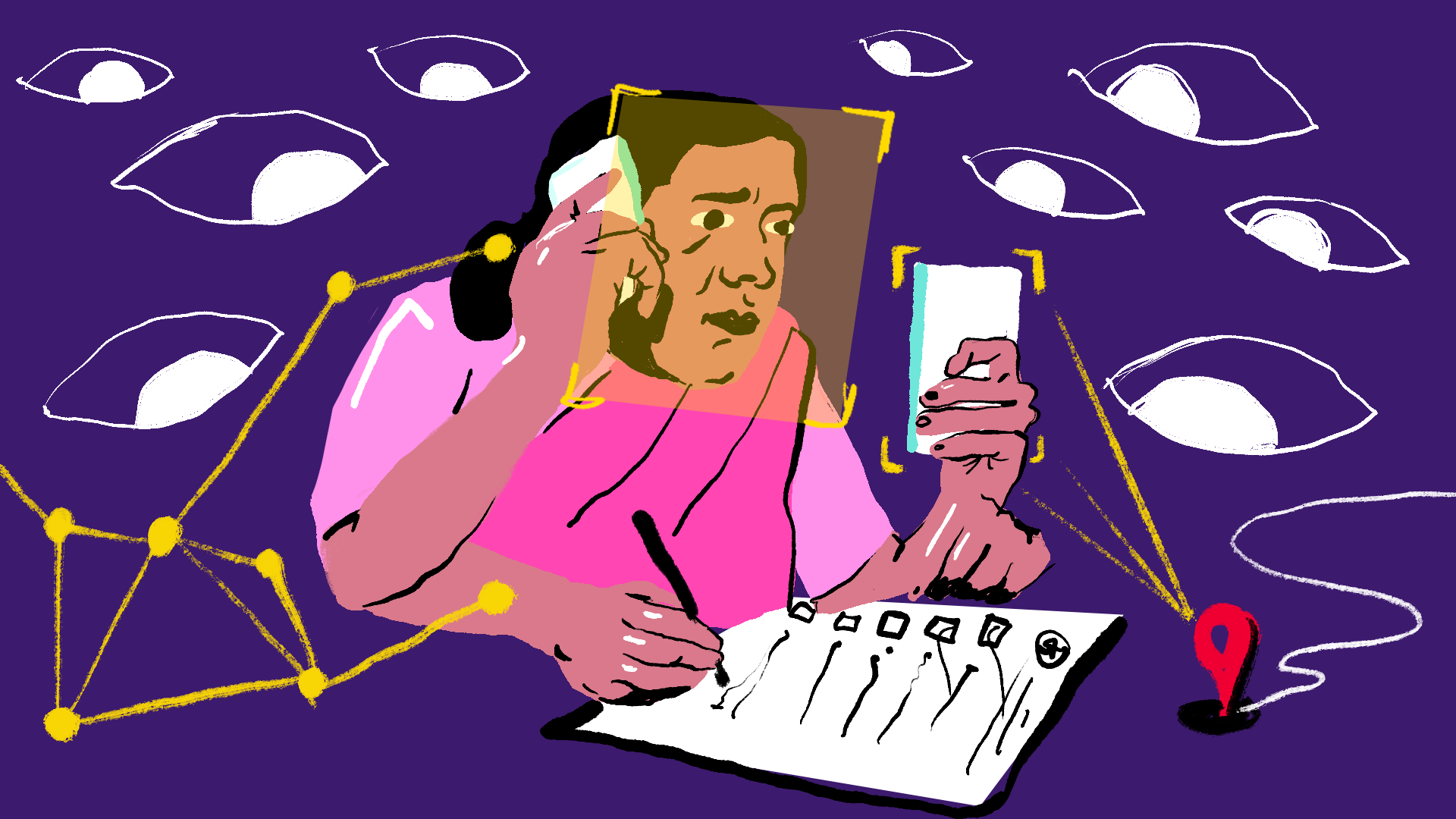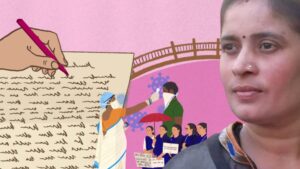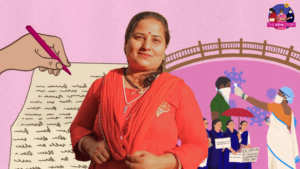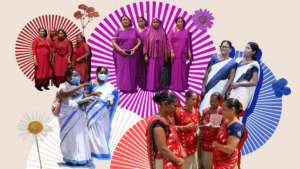Why A Photo-Backed Attendance App Is Distressing Maharashtra’s ASHA Workers
In Chhatrapati Sambhajinagar, the municipal commissioner has introduced a mandatory digital attendance system through a private app. ASHA workers, who are not considered government employees, are also forced to mark attendance thrice a day

For the last two months, 43-year-old Vaishali Borade has barely slept. The ASHA worker is the only earning member of her family and provides for her sick husband and disabled daughter. The low and irregular ‘honorarium’ she earns as an ASHA worker forces her to take up part-time jobs. But the recent introduction of a mandatory attendance system does not allow Vaishali to keep her part-time jobs, forcing her to work all night, forsaking rest.
“Earlier, I could reach home by 5 pm and between 6 pm and 7:30 pm, I worked as a cook,” said Vaishali. She earned Rs 2,500 from each of the two households that employed her. At night, around 8 pm she would sell vadas at a neighbouring park. This earned her around Rs 200 a day.
In January, this routine that ensured the survival of Vaishali’s family was disrupted when the municipal commissioner of Chhatrapati Sambhajinagar city (formerly Aurangabad) introduced a private attendance application. The app, called Hajeri (meaning attendance), mandated that all employees in the corporation mark their attendance thrice a day using photographic evidence. This was also extended to ASHA workers in the area.
To mark attendance, the workers have to now login to the app and select the date and upload a photograph. It requires continuous access to the phone’s files, photos, camera and location.
And suddenly, ASHA workers who could leave for home in the afternoon after finishing their duties had to stay at their health centres till 5-5:30 pm. “We have to mark our attendance in the morning around 9 am, in the afternoon around 2 pm and in the evening around 5-5:30 pm. We have to stay present for a minimum of eight hours. If we do the first attendance at 9:30, we have to wait till 5:30,” said Manasi Vetakar, an ASHA workers’ union leader from the city.
Since her work commute takes an hour, Vaishali can no longer reach the homes where she cooks in time. “I have not been paid my wages as an ASHA worker since November. So I had to look for other jobs,” she said.
Vaishali has taken on another job now, to fit the new work schedule at the health centre. At 8 pm in the night, she starts her second job as a home nurse to an elderly man. She goes home at 7 am, the next day, and then gets ready for her day as an ASHA worker.
The ASHA workers we interviewed pointed out that they were being forced to work regular office hours though they are classified as “honorary volunteers”. They also complained of the intrusive nature of this new digital attendance format.
The more than 1 million ASHA workers in the country form the critical link between people and the healthcare system. For over the last 20 years, their dedicated work has led to marked improvement in infant and maternal mortality and other crucial health indicators. To honour their immense contribution, we have built The ASHA Story, a feminist historiography of the women workers.
Despite their crucial role, ASHA workers are only paid an honorarium and task-based incentives. The initial ask from them was 8-12 hours of work per week but over time, the workload has increased but the pay remains below minimum wage. ASHA workers across the country have been for years demanding formalisation of their work, regular liveable wages and other benefits of government employment like maternity leave and pension.
The ASHA workers in Sambhajinagar said they are using the attendance app despite their reservations because they do not want to lose their jobs. The union leaders we interviewed said they have spoken to the municipal commissioner, and he has assured them that the ASHA workers need to mark attendance for only 4 hours a day, instead of the full day. But he is yet to put it in writing and because of that, the medical officers continue to force the workers to mark attendance for the entire day.
The workers said they are hurt by the officials’ lack of trust in their work ethics, though it is exemplary and impactful. The surveillance also raises issues of violation of privacy and the skewed power dynamics between the employer and the employed, highlighting how it ends up worsening inequalities instead of erasing them. Moreover, the recently passed Digital Personal Data Protection (DPDP) Act has reduced the protection for sensitive data.
'Is This the Payback We get?'
Given that ASHA workers are classified as ‘volunteers’ despite their workload, demanding of them the kind of commitment required of full-time government workers is unfair, said 42-year-old Rekha Gaikwad, an ASHA worker from Sambhajinagar. “They are holding us to a schedule like they would full-time employees. If we are volunteers, why do we have to stay the full day?” she asked.
Since April last year, the government has been cutting ASHA workers’ payments, Rs 10,000 a month, based proportionately on the leave they take, alleged the ASHA workers we interviewed. This amounts to an approximate Rs 330 cut for every day of leave.
In August 2024, when Manasi had an abnormal pulse complaint and had to be hospitalised, she took 10 days off. Her next payment was Rs 3,900 less. “After I came back from leave, I finished all my pending tasks. So I don’t know on what basis they are cutting our payments. Even machines need to stop working for repairs and we are just humans,” she said.
Rekha also highlighted the double standards on taking time off. “Other workers in the healthcare centre like the Auxiliary Nurse & Midwives (ANMs) are employees so they have paid leave. We are not employees but there is no government notification that says we cannot take leave,” she said.
The home page is a dashboard that shows how many days a worker has been present, absent and how many half days they have taken. It also shows how many weekly offs, paid and unpaid leaves that they are entitled to. The screenshot of the dashboard shared by an ASHA worker showed the number of entitled leaves to be zero.
Earlier ASHA workers in the city would finish their fieldwork and finish their remaining work when they had the time, said 40-year-old Ashwini, who has been an ASHA worker since 2020. “Now, we finish our field work and then go to the centre and sit there, waiting for it to be 5 p.m,” she pointed out.
This app system has impacted many ASHA workers’ part-time jobs taken on to supplement the monthly earnings of Rs 10-14,000 a month which too is irregular. Like Vaishali, Ashwini, Rekha and Manasi also had to give up their part-time jobs. “Private companies will not wait for you to be free, they want you to be available when they need the work done,” said Ashwini who used to work at a medical store for a couple of hours.
The women also complained about being roped into tasks that are not their responsibility when they wait to mark presence till 5pm. “Sometimes we are told to do online data work or do some cleaning, neither of which is our job. And we did it one day to help out. But then the next day, they yell at us for not doing it proactively, as if it was our responsibility,” said Ashwini.
Information and Surveillance
“Privacy is dignity. Not having to prove your existence through data is a part and parcel of the right to privacy,” said technology and rights researcher Disha Verma, referring to the 2017 Puttaswamy judgement which held privacy as a fundamental right. “By introducing this app and making it mandatory, you are breaching the dignity and you’re undermining your ASHA workers.”
This is not the first time an app has been introduced to surveil ASHA workers. In May 2021, the Haryana government made ASHA workers install an app called Shield360, intended to monitor daily targets. But the app went beyond and had provisions to monitor real-time movements of ASHA workers and their usage of other apps and the internet. It also allowed officials to remotely add, delete or update any information or mobile applications on the phones.
The app was discontinued after protests from ASHA workers in the state. “ASHA workers get very little from the state. Low and late payment, little protection and no employment benefits. Bringing in a layer of distrust on top of this fragile relationship with something like an attendance app is demeaning,” Disha pointed out.
Digital solutions to monitor and track workers has been a growing trend in India. In 2020, at least seven municipal corporations in the country had introduced GPS-enabled tracking devices for sanitation workers. In March 2021, the central government launched the POSHAN tracker app, which enabled real-time monitoring and tracking of all Anganwadi centres, Anganwadi workers and beneficiaries. In May 2023, we reported how the app has added to the list of tasks for the already underpaid and overworked Anganwadi workers, reducing them from scheme deliverers to data collectors.
The same year, the government also introduced the National Mobile Monitoring System (NMMS), an attendance application for workers under the Mahatma Gandhi National Rural Employment Guarantee Scheme (MGNREGS). In addition to weakening the scheme’s provisions for transparency and accountability, the app has caused wage losses and distress to workers and front-line functionaries, found a study by LibTech on the impact of the app at 50 MGNREGS worksites in five states. LibTech is a collaborative research project that includes engineers, social workers and social scientists.
One of the main problems with such tech interventions is information asymmetry, said Laavanya Tamang, who was part of the research team at LibTech. “No one explains anything. You are just told that this is the new system, you just have to fall in line or risk losing out on your entitlements,” she said.
There is a clear power imbalance between the surveillant and the person being surveilled, as we said earlier. And this power differential makes free consent impossible. “Even if tomorrow ASHA workers were allowed to opt out of such an application, their jobs and incomes are on the line. What if the state starts discriminating against them?” asked Disha.
Moreover, such surveillance leads to further concentration of power.
No Lines Between Private, Public
The ASHA workers in Sambhajinagar have not received any information on how the data collected from their phones will be processed, who will have access to the data and what kind of pay cuts or consequences they will have to face for not marking the attendance in the application. “We are complying because we cannot afford to lose more income,” said Vaishali.
Since January 1, the ASHA workers union in the city has written five letters to the commissioner, requesting a meeting. In February, Netradipa Patil, the state coordinator of Maharashtra-based ASHA workers’ union, travelled from Kolhapur to Sambhajinagar for a meeting but the commissioner did not meet them.
“On March 17, the commissioner met with us and said that we only need to mark for four hours but we will have to keep using the app. He has not yet put it on paper so medical officers are still forcing us to stay till 5 pm,” said Manasi.
Surveillance is almost always without consent, said Disha, adding that if there is no consent, then the collected data should not be processed to ensure privacy, especially sensitive data like our faces. “We can change our house address, bank details, phone number any day in case of data leak or abuse but we cannot change our face,” she reasoned.
Earlier laws had improved protection for such sensitive data. The Information Technology (Reasonable Security Practices and Procedures and Sensitive Personal Data or Information) Rules, also called the SPDI Rules 2011 considered “facial patterns” as biometric information and categorised it as sensitive. The rules demanded written consent for collecting sensitive data, informing the concerned person that the data is being collected, its purpose, intended recipients and the name and address of the agency collecting and retaining the data.
In 2023, the DPDP Act was passed and the SPDI rules were no longer applicable. Under the new act, all personal data is considered equal. “So your face and genetic information is [considered] as sensitive as your email ID. It is very comical and a bad approach to data processing policy,” said Disha. This removal of extra checkpoints and protections for sensitive data, she alleged, is useful in normalising surveillance to allow the private sector to make surveillance tools.
The DPDP Act also grants the government a lot of exemptions, especially on how private companies deal with data. The Hajeri app that was introduced in Sambhajinagar was developed by AM Ventures Private Limited, a local company. The website of the application says that it has the “world’s best face authentication system” that works on an “AI architecture” and that employees can only mark their attendance within specified geolocation.
With a private company making the app, there is lack of transparency around the flow of data. “Maybe the private entity is making disclosures to the government. But as soon as you get a public-private relationship, the data flows are not very well governed by the DPDP Act or any of our other laws,” said Disha.
An exemption under the act allows the government to give data to third parties or private persons that they have a contract or relationships with. Disha pointed to the dangers of this give and take: the app provider would pass on attendance information to the government, but would also be able to access information from it.
There are vaguely worded scenarios in which the government does not have to seek consent, which can easily be applied to ASHA workers, according to Disha. For example, the act says personal data can be processed by the government for issuing benefits and subsidies or for “security” reasons”. “So, the government doesn’t have to take consent from ASHA workers to process their information and especially to survey them, because they can always say that it’s for the larger public health interest,” said Disha.
In Sambhajinagar, all Manasi and other ASHA workers want justice. They hold up the country’s healthcare system and critical data collection work but have no voice in how their own rights as workers and individuals are treated. “Permanent employees do not have as many restrictions as we do,” Manasi said.
Municipal Commissioner's Response
On April 8, after this story was published, Municipal Commissioner G Sreekanth spoke to us over the phone. The commissioner reasoned that ASHA workers are paid a fixed honorarium and hence they must be monitored. “Yes, they are not regular employees. They are paid a fixed honorarium even if they don’t do anything. [Since] they are paid an honorarium, there should be an action”, he told Behanbox. “Should I not know how many ASHA workers have come in today? Where are they? What are they doing? On my fingertips. What is the harm in knowing?”, he said while justifying the app and attendance system.
He claimed that as long as they were on the government’s payroll, they ought to be monitored. “They are under my payroll, the government payroll. This does not mean they do not come under the definition of employees. What definition do they come under [if not employees]? Daily wage labourers? Honorary employees? Why should we not monitor honorary employees?”, he said.
The commissioner told us that he would recommend this app as an innovative solution to the chief minister of Maharashtra. “Earlier, offices had biometric or manual registers. In registers, ASHA workers and doctors used to collude and falsify their attendance”, he asserted.
He dismissed the privacy concerns about using facial recognition or using an app developed by a private company. “What is the problem with facial attendance (sic). They have a smartphone and security and privacy. It [data] is with the corporation only.” He said that the private company has no access to the data which is explicitly mentioned in the contract. “They don’t have any access. They can’t share this data. They can’t do anything. It is totally under our control. If they do this, it will be a criminal violation. It is purely for administrative purposes to monitor our employees for their performance.”
On facial recognition, he said that it was already a part of the ‘smart city’ infrastructure. “Our phones have facial-recognition based unlocking. 90 to 95% people use this. What does the smartphone mean? [Is it] just [for] using WhatsApp and Facebook and Instagram?”
We believe everyone deserves equal access to accurate news. Support from our readers enables us to keep our journalism open and free for everyone, all over the world.




